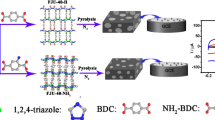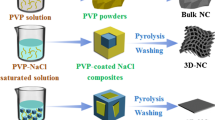Abstract
It is a top priority to simultaneously and accurately detect hydroquinone (HQ) and catechol (CC). Here, a new strategy for constructing simultaneous determination of HQ and CC sensor was proposed by one-step pyrolysis of MIL series metal-organic frameworks materials (MIL-125 (Ti), MIL-101 (Cr), and MIL-101 (Fe)) to obtain uniform-mixed carbon/metal oxide porous materials (TiO2/C900, Cr2O3/C900, and Fe2O3/C900, respectively). And, cyclic voltammetry (CV) was utilized to investigate the electrochemical behavior of the composite materials. It was found that the simultaneous detection of catechol (CC) and hydroquinone (HQ) could be achieved by the sensor consisted of TiO2/C900 with the superior BET-specific surface area and micro-mesoporous characteristics. And, the linear range and detection limit of HQ and CC for the TiO2/C900 sensor were further studied. In addition, it was also found that the pyrolysis temperature and metal centers would affect the internal structures and component of the materials, thus affecting the properties of materials. The experiment provides a new idea for optimizing the simultaneous detection of the dihydroxybenzene isomers.

A new feasible strategy was proposed by introducing the binary uniform-mixed carbon/metal oxide porous materials, by which the calcination temperature and the metal centers of MOFs would be considered to construct the sensor for simultaneous determination of catechol (CC) and hydroquinone (HQ).







Similar content being viewed by others
References
Figueiredo EC, Tarley CRT, Kubota LT, Rath S, Arruda M (2007) A Z Microchem J 85(2):290–296
Prathap MUA, Satpati B, Srivastava R (2013) Sensors Actuators B Chem 186:67–77
Taysse L, Troutaud D, Khan NA, Deschaux P (1995) Toxicol 98(1-3):207–214
Song D, Xia J, Zhang F, Bi S, Xiang W, Wang Z, Xia L, Xia Y, Li Y, Xia LH (2015) Sensors Actuators B Chem 206:111–118
Nagaraja P, Vasantha RA, Sunitha KR (2001) J Pharm Biomed Anal 25(3-4):417–424
Asan A, Isildak I (2003) J Chromatogr A 988(1):145–149
Moldoveanu SC, Kiser M (2007) J Chromatogr A 1141(1):90–97
Pistonesi MF, Di NM, Centurión ME, Palomeque ME, Lista AG, Fernández Band BS (2006) Talanta 69(5):1265–1268
Ding YP, Liu WL, Wu QS, Wang XG (2005) J Electroanal Chem 575(2):275–280
Liu X, Li Y, Liu X, Zeng X, Kong B, Luo S (2012) J Solid State Electrochem 16(3):883–889
Si W, Lei W, Zhang Y, Xia M, Wang F, Hao Q (2012) Electrochim Acta 85:295–301
Nagaraja P, Vasantha RA, Sunitha KR (2001) J Pharm Biomed Anal 25(3-4):417–424
Zhao C, Song JF, Zhang JC (2002) Anal Bioanal Chem 374(3):498–504
Carvalho RMD, Mello C, Kubota LT (2000) Anal Chim Acta 420(1):109–121
Xu CX, Huang KJ, Fan Y, Wu ZW, Li J, Gan T (2012) Mater Sci Eng C 32(4):969–974
Chen X, Wu G, Chen J, Chen X, Xie Z, Wang X (2011) J Am Chem Soc 133(11):3693–3695
Lv X, Zhang G, Fu W (2012) Procedia Eng 27:570–576
Bao S, Li CM, Zang J, Cui X, Qiao Y, Guo J (2010) Adv Funct Mater 18:591–599
White RJ, Luque R, Budarin VL, Clark JH, Macquarrie DJ (2009) Cheminform 40:481
Wang YJ, Wilkinson DP, Zhang J (2011) Chem Rev 111(12):7625–7651
Yin H, Tang H, Wang D, Gao Y, Tang Z (2012) ACS Nano 9:8288
Wu B, Hu D, Kuang Y, Yu Y, Zhang X, Chen J (2011) Chem Commun 47(18):5253–5255
Ziyatdinova G, Morozov M, Budnikov H, Grazhulene S, Red’Kin A (2012) J Solid State Electrochem 16(1):127–134
Yang Y, Ren Y, Sun C, Hao S (2014) Green Chem 16(4):2273–2280
Wang L, Zhang Y, Du Y, Lu D, Zhang Y, Wang C (2012) J Solid State Electrochem 16(4):1323–1331
Ma XM, Liu ZN, Qiu CC (2013) Microchim Acta 180(5-6):461–468
Lee J, Kim J, Hyeon T (2011) Adv Mater 18:2073–2094
Zhang Y, Zeng L, Bo X, Wang H, Guo L (2012) Anal Chim Acta 752:45–52
Wang W, Yang K, Gaillard J, Bandaru P, Rao A (2010) Adv Mater 20:179–182
Zhang Y, Xiao S, Xie J, Yang Z, Pang P, Gao Y (2014) Sensors Actuators B Chem 204:102–108
Zhang JP, Zhang YB, Lin JB, Chen XM (2012) Chem Rev 112(2):1001–1033
Li ZY, Zhang ZJ, Ye YX, Cai KC, Du FF, Zeng H, Tao J, Lin QJ, Zheng Y, Xiang SC (2017) J Mater Chem A 5(17):7816–7824
Li WH, Ding K, Tian HR (2017) Adv Funct Mater 27(27):1702067
Hou CT, Xu Q, Yin LN, Hu XY (2012) Analyst 137:5083
Liu B, Shioyama H, Akita T (2008) J Am Chem Soc 130(16):5390–5391
Lai T, Cai W, Dai W, Ye J (2014) Electrochim Acta 138:48–55
Chen L, Tang Y, Wang K, Liu C, Luo S (2011) Electrochem Commun 13(2):133–137
Zhou J, Li X, Yang L, Yan S, Wang M, Cheng D, Chen Q, Dong Y, Liu P, Cai W, Zhang C (2015) J Anal Chim Acta 899:57–65
Huang YH, Chen JH, Sun X, Su ZB, Xing HT, Hu SR, Weng W, Guo HX, Wu WB, He YS (2015) Sensors Actuators B Chem 212:165–173
Feng S, Zhang Y, Zhong Y, Li Y, Li S (2014) J Electroanal Chem 733:1–5
Nematollahi D, Alimoradi M, Husain SW (2004) Electroanalysis 16(16):1359–1365
Zhang Y, Zheng JB (2007) Electrochim Acta 52:7210–7216
Nematollahi D, Ariapad A, Rafiee M (2007) J Electroanal Chem 602:37–42
Shanmugam VM, Kulangiappar K, Ramaprakash M, Vasudevan D, Kumar RS, Velayutham D, Raju T (2017) Tetrahedron Lett 58:2294–2297
Acknowledgments
The authors gratefully acknowledge the financial supports of the National Natural Science Foundation of China (21207018, 21673039, and 21573042), Natural Science Foundation of Fujian Province (2015J01039, 2018J07001), and Environment and Land Resources Bureau of Pingtan Comprehensive Experimentation Area (DH-1374).
Author information
Authors and Affiliations
Corresponding authors
Additional information
Highlight
1. Binary uniform-mixed carbon/metal oxide porous materials by one-step pyrolysis of MOFs were firstly used to construct the electrochemistry sensor.
2. The electrocatalysis performance of materials can be regulated by adjusting the calcination temperature and the metal centers of MOFs.
3. A promising sensor for the simultaneous determination of dihydroxybenzene isomer has been developed.
Electronic supplementary material
ESM 1
(DOC 1265 kb)
Rights and permissions
About this article
Cite this article
Wang, Z., Li, M., Ye, Y. et al. MOF-derived binary mixed carbon/metal oxide porous materials for constructing simultaneous determination of hydroquinone and catechol sensor. J Solid State Electrochem 23, 81–89 (2019). https://doi.org/10.1007/s10008-018-4111-z
Received:
Revised:
Accepted:
Published:
Issue Date:
DOI: https://doi.org/10.1007/s10008-018-4111-z




